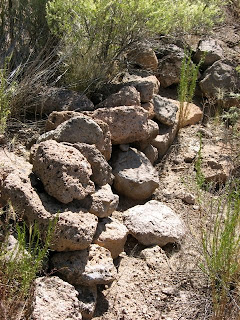 To celebrate the upcoming statehood centennial in 2012, New Mexico is introducing a new license plate design in January. According to the state's website, the Centennial plate features "a 'retro' design--a classic look, using red and yellow colors from the state flag and the Zia; and a bold turquoise background, reflecting the state gem."
To celebrate the upcoming statehood centennial in 2012, New Mexico is introducing a new license plate design in January. According to the state's website, the Centennial plate features "a 'retro' design--a classic look, using red and yellow colors from the state flag and the Zia; and a bold turquoise background, reflecting the state gem." The plate replaces the so-called "balloon plate", which has been around for the past 10 years.
 The question the Governor has for you is the following. Should this be the only standard (i.e. no extra charge) plate available to New Mexicans, or should they continue to be able to choose the other current standard plate, cleverly known as "the yellow plate"?
The question the Governor has for you is the following. Should this be the only standard (i.e. no extra charge) plate available to New Mexicans, or should they continue to be able to choose the other current standard plate, cleverly known as "the yellow plate"?
If you'd like to vote, click here to go the state's license plate survey website.
 Those who are willing to spend an extra $25 can forego the above choice(s) and instead acquire the new Santa Fe 400th anniversary license plate, which will be available after Labor Day. The extra $25 will go to offset the costs of the 400th anniversary celebration.
Those who are willing to spend an extra $25 can forego the above choice(s) and instead acquire the new Santa Fe 400th anniversary license plate, which will be available after Labor Day. The extra $25 will go to offset the costs of the 400th anniversary celebration.
 The question the Governor has for you is the following. Should this be the only standard (i.e. no extra charge) plate available to New Mexicans, or should they continue to be able to choose the other current standard plate, cleverly known as "the yellow plate"?
The question the Governor has for you is the following. Should this be the only standard (i.e. no extra charge) plate available to New Mexicans, or should they continue to be able to choose the other current standard plate, cleverly known as "the yellow plate"?If you'd like to vote, click here to go the state's license plate survey website.
 Those who are willing to spend an extra $25 can forego the above choice(s) and instead acquire the new Santa Fe 400th anniversary license plate, which will be available after Labor Day. The extra $25 will go to offset the costs of the 400th anniversary celebration.
Those who are willing to spend an extra $25 can forego the above choice(s) and instead acquire the new Santa Fe 400th anniversary license plate, which will be available after Labor Day. The extra $25 will go to offset the costs of the 400th anniversary celebration.


